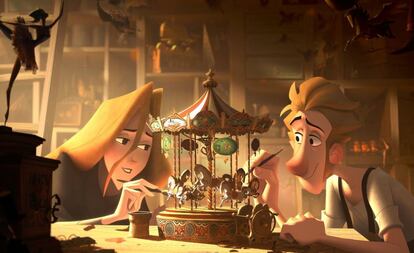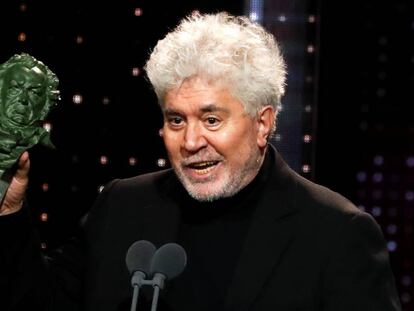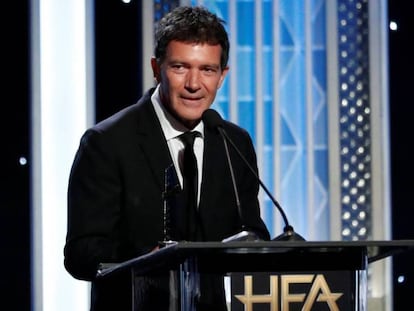Spanish animation feature ‘Klaus’ hopes for Academy Award glory
The Netflix co-production has already won a BAFTA and seven Annies, the industry equivalent of the Oscars


It’s Wednesday morning at The SPA Studios. The final Academy Award voting ended just a few hours ago. The Spanish animation movie Klaus is nominated for an Oscar for Best Animated Feature. There is some nervous laughter among the few employees still left in the studio, which is located in a dull-looking office building outside Madrid, where the A-6 freeway meets the M-40 ring road.
At the studio of Sergio Pablos Animation, there are 20 or so people at this point, but for three years there were nearly 300 workers from 22 countries, speaking 15 languages. Those familiar with the animation industry know that animators follow the projects, wherever in the world they happen to be.
The odd drawing for Klaus – a Christmas comedy that puts a spin on the origin story of Santa Claus – can still be found hanging from the walls. A co-production between Spanish production company Atresmedia Cine and streaming giant Netflix, the film has already won seven Annies – the Oscars of the animation world – and a British Academy Film Award (BAFTA). This coming Sunday it hopes to add an Academy Award to its haul of prizes.
Carlos Martínez, 41, is sitting inside the room once used to screen the daily progress of the film while the project was still underway. Although he is listed on the Internet Movie Database (IMDB) as co-director of Klaus, Martínez has trouble defining the exact nature of his role.

“I’ve been an artistic assistant to production, and I acted as coordinator whenever Sergio couldn’t make it,” he explains, speaking for his boss in the latter’s absence. “I went to the Goya [Spanish film awards] while he was at the Annies that night. It was amazing because we won in all the categories we were competing in. Seven out of seven. Sergio continued campaigning in the United States, then traveled to London for the BAFTAs, then back to the US.”
The flurry of international activity also explains the deserted feeling at the studios. “The studio boss is busy going from one award to another, and we still haven’t started our next project,” he says with a chuckle.
Sergio Pablos, a 50-year-old from Madrid, is one of the best-known Spanish names in the world of animation. He started out at the Disney studios in Paris and from there moved on to the company headquarters in California. He animated the characters of Claude Frollo, the villain of the The Hunchback of Notre Dame, the Greek God Hades in the fantasy feature Hercules, Tantor the elephant in Tarzan, and Doctor Doppler in the sci-fi adventure Treasure Planet. There are posters for all of these movies hanging on the walls of the studio.
Raising money for an animation movie from Spain is very complicatedCarlos Martínez, coordinator
Pablos left Disney to create his own movies. He had the original ideas for the comedy Despicable Me, which he sold to the film studio Universal Pictures, and for the musical comedy Smallfoot. He also worked on the box office hit Rio. “Raising money for an animation movie from Spain is very complicated,” notes Martínez. “Every project goes through difficulties. Atresmedia Cine began producing Klaus, but more money was still required.”
Netflix finally came on board after initially rejecting the proposal, and the budget was raised to €40 million. “People don’t know how hard it is to make an animation movie. Like Sergio says, Christmas belongs to Disney: what with [animation studio] Pixar, Star Wars, Marvel [comic-inspired films]... But Netflix was looking for a movie for this season, and what was once a problem turned out to be the best weapon for Klaus.”
Pablos had the idea for Klaus in 2010, when he decided to create the origins of legendary characters. Santa Claus was the first to come to mind. And it was the first one to get rejected. “Some time later he thought of a cynical twist, and he found a different viewpoint using the character of the selfish mailman, who triggers the opposite attitude, generosity, through a carpenter named Klaus,” explains Martínez.
“It had been a long time since anyone made a 2D movie of such high quality, where each animator faces a blank screen and needs to draw by hand. Modern-day animation works with 3D, with a character that’s already been created. We innovated with the lighting in order to preserve the carefully crafted concept of the first drawings,” he adds.
Martínez and Pablos had worked together earlier on Chico & Rita, the first Spanish feature animation to be nominated for an Oscar in 2012. Now, with an Oscar win closer than ever, he believes that the race is “wide open,” but that Klaus stands a good chance.
English version by Susana Urra.
Tu suscripción se está usando en otro dispositivo
¿Quieres añadir otro usuario a tu suscripción?
Si continúas leyendo en este dispositivo, no se podrá leer en el otro.
FlechaTu suscripción se está usando en otro dispositivo y solo puedes acceder a EL PAÍS desde un dispositivo a la vez.
Si quieres compartir tu cuenta, cambia tu suscripción a la modalidad Premium, así podrás añadir otro usuario. Cada uno accederá con su propia cuenta de email, lo que os permitirá personalizar vuestra experiencia en EL PAÍS.
¿Tienes una suscripción de empresa? Accede aquí para contratar más cuentas.
En el caso de no saber quién está usando tu cuenta, te recomendamos cambiar tu contraseña aquí.
Si decides continuar compartiendo tu cuenta, este mensaje se mostrará en tu dispositivo y en el de la otra persona que está usando tu cuenta de forma indefinida, afectando a tu experiencia de lectura. Puedes consultar aquí los términos y condiciones de la suscripción digital.
More information
Últimas noticias
From digital curfews to blocking apps: How technology experts protect their children online
Why the price of coffee has skyrocketed: from Brazilian plantations to specialty coffee houses
Confined to a Cuban hospital: When electricity is a matter of life or death
The complicated life of Francesca Albanese: A rising figure in Italy but barred from every bank by Trump’s sanctions
Most viewed
- Why we lost the habit of sleeping in two segments and how that changed our sense of time
- Trump’s obsession with putting his name on everything is unprecedented in the United States
- Pablo Escobar’s hippos: A serious environmental problem, 40 years on
- The Florida Keys tourist paradise is besieged by immigration agents: ‘We’ve never seen anything like this’
- Charles Dubouloz, mountaineering star, retires at 36 with a farewell tour inspired by Walter Bonatti










































